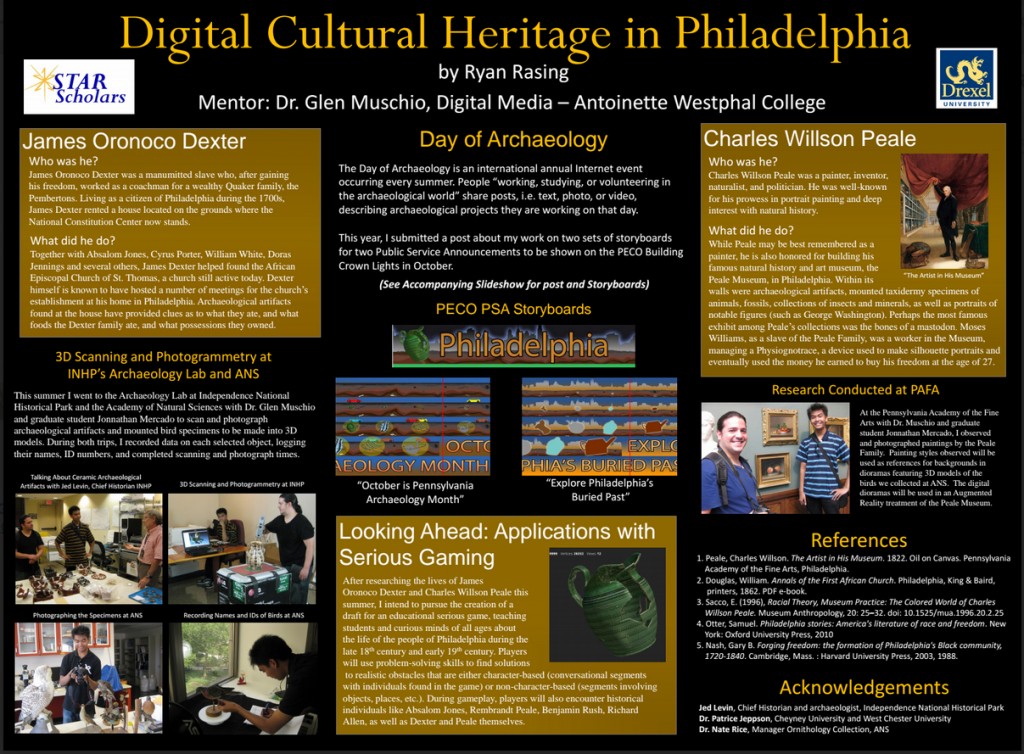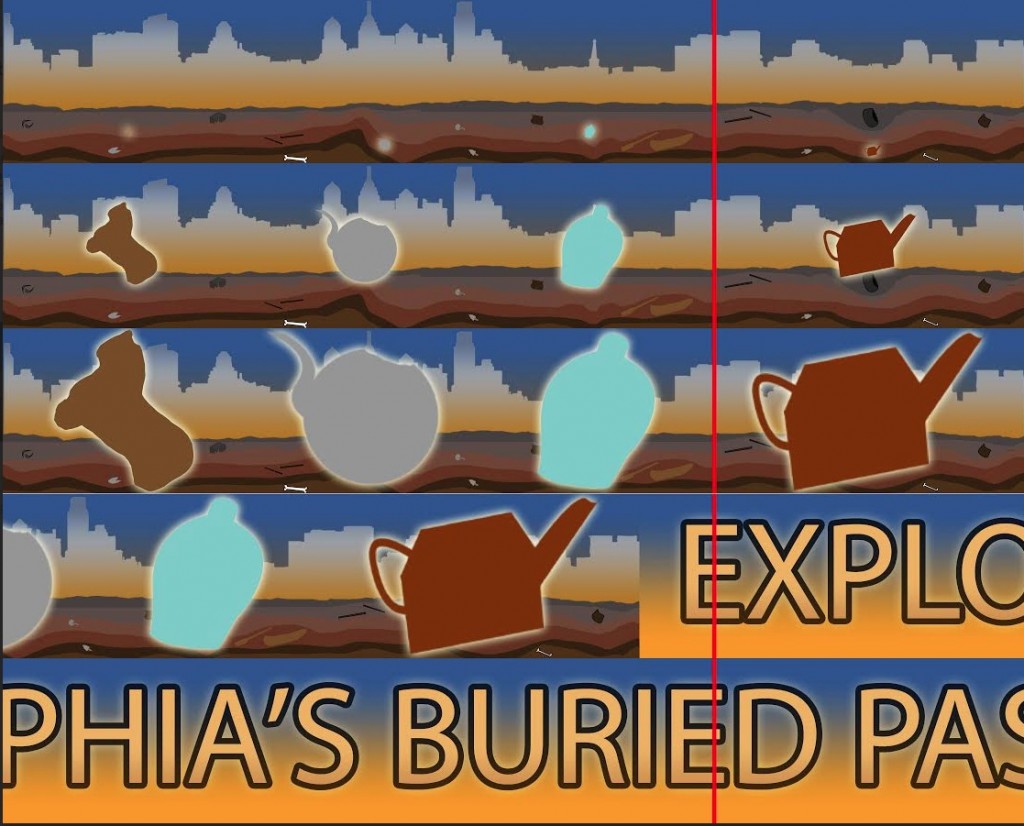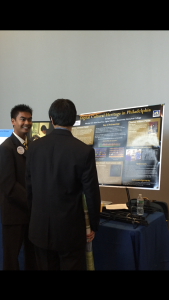September 2015 – Artifact of the Month
To Artifact of the Month Index
To PAF Home
~~~ ~~~
STORYBOARDING ARCHAEOLOGY MONTH IN PHILADELPHIA
This month’s featured object is a modern-day artifact — a newly created storyboard that plots out a scene about archaeological evidence buried beneath the city of Philadelphia. Storyboards are a sequence of drawings that unfold, graphic-by-graphic, ‘pre-visualizing’ a proposed project such as a movie, a theater production, or a novel.
This particular storyboard is one step in the production of a set of Public Service Announcement videos (PSAs) being designed and created by Drexel University Digital Media researchers and the Philadelphia Archaeological Forum. The PSAs are intended to help promote archaeology in Philadelphia as part of a Pennsylvania Archaeology Month (October) awareness campaign. It is an ‘artifact’ of the field of archaeological research known as ‘Digital Public Archaeology’.
The storyboard was created by Ryan Rasing, a Drexel University undergraduate in the Students Tracking Advanced Research (STAR) Scholars Program (and was updated for 2016 by Brendan Luu). Ryan’s efforts represent an early step in the production of a 30-second long, 3D-animated, Public Service Announcement video (PSA) promoting Philadelphia’s annual Archaeology Month event, Explore Philly’s Buried Past!. The storyboard is a required element for proposing the archaeology-themed Public Service announcement videos for use on the EXELON/PECO Headquarters ‘Crown Light’s’ marquee which projects 40 foot high messages by community and non-profit organizations from the 27th story of a downtown Philadelphia skyscraper. According to PECO (the Pennsylvania Electric Company), as many as 100,000 people see the messages broadcast on their Crown Lights platform.
Rasing is studying Game Design and Production in the Digital Media Department in Drexel’s Antionette Westphal College of Media Arts and Design. He worked on the new PSA project under the direction of Dr. Glen Muschio, and in association with grad student Jonnathan Mercado in the Digital Media Department. This new PSA, part of a set of two, will replace an older PSA that Drexel researchers made on behalf of the Philadelphia Archaeological Forum in 2011. (See this previous archaeology-themed PSA projected from the PECO Marquee here….)
The new storyboard’s illustrative sequence (and eventually, the forthcoming PSA animated video it outlines) begins with Philadelphia’s skyline shown resting atop of several layers of soil that make up the ground surface. (See Storyboard 1, above.) Prehistoric animal bones are shown in the lowest layers of soil in the ground, with Native American objects found in layers above those. In still higher levels, small images of historical period objects related to life in 18th and 19th century Philadelphia are depicted. A tire and wood pieces are shown in the top (most recently laid down) soil layers, just below the city street level.
The sequence of illustrations continues with several of the 18th and 19th century artifacts emerging, graphic by graphic, out from the soil layers, growing larger in size until these objects partly block out the skyline/ground background. The depicted artifacts represent actual objects that archaeologists have excavated from the city within the boundaries of Independence National Historical Park. The storyboard presents only representative ‘place-holder’ images of these artifacts: a toy wooden horse, a hand-painted creamware teapot, a red engine-turned teapot, and a glass flask. In the 3D-animated, PSA video these objects will be depicted using digitized images of the actual objects.
At this point in the storyboard sequence, the city scene exits and a text message appears reading “Explore Philly’s Buried Past”. (In the forthcoming video this text message will read “Explore Philly’s Buried Past! Sat. Oct. 10 www.phillyarchaeology.org“.)
Most of the artifacts referenced in the storyboard (and in the forthcoming two new PSA videos) come from excavations conducted at the site of the National Constitution Center whose footprint encompassed an area of more than 100 house lots dating from the 18th and 19th century. (One of the artifacts used for a second PSA comes from Franklin Court which is Benjamin Franklin’s ‘mansion’ house site.) The artifacts were selected for this use by the Independence National Historical Park’s Chief Historian and archaeologist, Jed Levin, and by Public Archaeologist Patrice Jeppson, in consultation with Glen Muschio (all three of whom are members of the Philadelphia Archaeological Forum).
In preparing for the forthcoming PSA videos (and hence the storyboarding), digitized images of the selected artifacts were created by Drexel University Digital Media grad student Jonnathan Mercado using a 3D scanner and photogrammetry techniques. STAR scholar Ryan Rasing then composited the digital graphics and digital 3D models of archaeological artifacts to produce the two animated Public Service Announcements using the Adobe After Effects digital editing software program.
This PSA storyboard debuted to the public on August 27th during a presentation by Rasing at Drexel’s 2015 STAR Scholars Summer Showcase. The forthcoming related video will be featured on the Philadelphia Archaeology Forum’s webpage when available. The video are scheduled to be broadcast on the PECO ‘Crown Lights’ marquee (5pm-5am) on the evenings of Sunday 9/27, Monday 9/28, and Tuesday 9/29 (with the second PSA running 10/19 and 10/20).

Rasing’s poster on creating the new archaeology month Public Service Announcements was presented at Drexel University on August 27th.
View the presented PSA poster here…
Learn more….
This PSA project, including the development of this storyboard, the artifacts at its base, and the 3D scanning and photogammetry technologies used to capture the selected artifact images will be featured at the “Explore Philly’s Buried Past, 2015!“ event on Saturday October 10th.
See the final PSAs here and here…
~ ~ ~
Information for this ‘Artifact of the Month’ write up by Patrice L Jeppson draws upon the work of Ryan Raising and Jonnathan Mercado. Updating of the PSA for 2016 was done by Brendan Luu.
by admin




